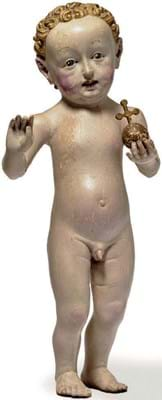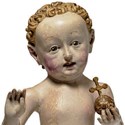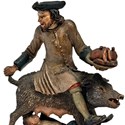The sale at Neumeister (27% buyer’s premium) in Munich on October 22-24 was a family affair.
On offer was the private collection of veteran auctioneer Rudolf Neumeister, who died in 2017. He was a patriarchal figure, an auctioneering institution who set numerous milestones during his long career.
In 1958 he had taken over the auction house Weinmüller and later changed its name to his own. He soon acquired major collectors as his customers, assisting them at all stages, first building up a collection and on many occasions later facilitating its dispersal. He experienced the boom years of the Wirtschaftswunder and correspondingly of the German art market.
Along the way he was responsible for numerous highlights. In 1979, for instance, he sold 54 Gothic sculptures from the Oertel Collection for a remarkable DM5.1m (in those days about £1.35m), taking just over an hour to complete the sale. He also achieved several individual million-mark hammer prices, in the days when seven-figure prices caused a national sensation.
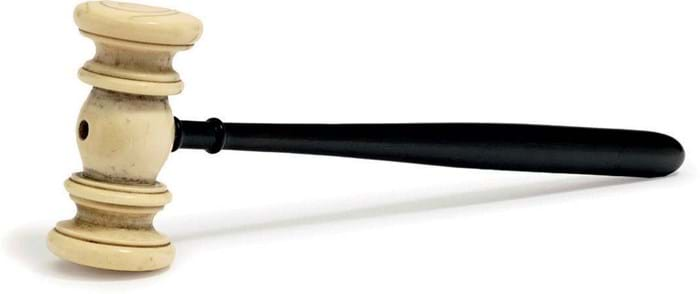
The perfect souvenir of an auctioneer-collector: a 19th century ebony and ivory gavel from Rudolf Neumeister’s private collection was knocked down for €1100 (£960).
For as long as he was an auctioneer, Neumeister built up an impressive private collection of his own.
According to his will, some 800 pieces he amassed were to be sold in his one-time rooms. This was no mean undertaking for Katrin Stoll, Neumeister’s middle daughter, who took over the running of the auction house in 2008. The focus was decidedly old-school with an emphasis on traditional fields: religious sculptures, German ceramics and silver, 19th century and Old Master paintings.
It was no surprise that a good many lots went to south German collectors – Neumeister’s traditional fan-base.
The first evening session was dedicated to the highlights of the collection and contained just over 80 lots. Like many collectors of his generation, Neumeister was fascinated by ceramics.
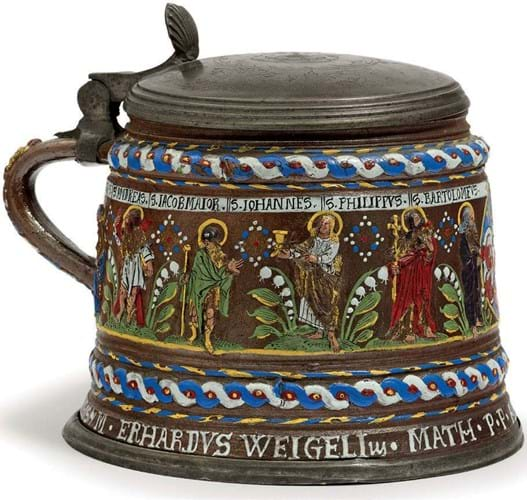
This pewter-mounted stoneware tankard, enamel-painted with the Twelve Apostles, was made in Creussen in 1662. It was one of several similar pieces in the Neumeister Collection and sold for €12,000 (£10,435).
In the run-up to the sale, there were some sceptical voices about whether there was still a market for 17th century stoneware tankards from Annaberg and Creussen, with cold-painted enamel decoration, often with depictions of Jesus and his disciples. The short answer is, perhaps surprisingly, ‘yes’. Several went way over the estimates, with top honours going to an apostle-tankard from 1662.
It reached €12,000 (£10,435), trebling its upper estimate in the process. There was, however, even more interest for the pewter-mounted Nuremberg Hausmaler jug (previewed in ATG No 2412) with a depiction of the Wedding at Cana, which changed hands for €19,000 (£16,520).
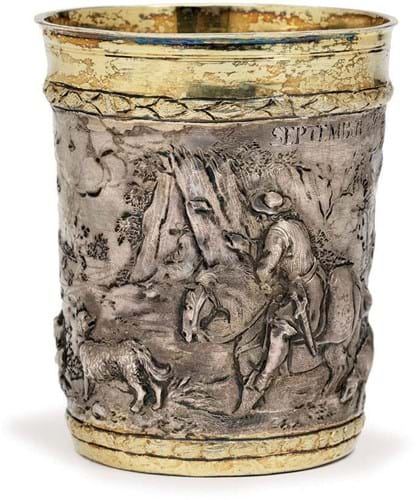
While working as a journeyman in his father’s workshop in the late 17th century, the Augsburg silversmith Johann Andreas Thelott created this month-beaker for September, which was knocked down to a Polish museum for a double-estimate €30,000 (£26,090) at Neumeister.
One category Neumeister apparently could not resist was parcel-gilt silver beakers and tankards. He was obviously fascinated by the differing surface patterns, with snakeskin being among his favourites.
The most sought-after piece in this section proved, however, to be a late 17th century parcel-gilt beaker dedicated to the month September, with the sign of the zodiac for Libra and figures of falconers and a maid harvesting fruit. It was made by the Augsburg silversmith Johann Andreas Thelott, while working as a journeyman in the workshop of his father Israel. The beaker doubled the upper guide when it was knocked down to a Polish museum for €30,000 (£26,090).
Mexican origin
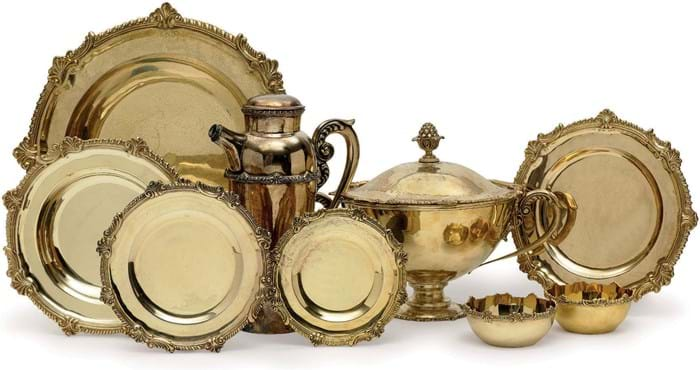
This 64-piece gilt silver service is thought to have belonged to Emperor Maximilian I of Mexico. Several bidders pushed the price from the guide of €11,000 to €29,000 (£25,220) at Neumeister.
On day two of the sale, numerous bidders took a liking to a 64-piece gilt silver table service, possibly of Mexican origin and probably once the property of Emperor Maximilian of Mexico. It sold for €29,000 (£25,220), far more than the guide of €11,000.
From time to time, Stoll enlivened the proceedings with anecdotes about her father and his collection.
At the beginning of the sculpture section, she told how she was visiting her father’s house in the country with her daughter. One inside wall was covered with antler trophies (Neumeister was a passionate hunter, not just of antiques but also wild animals. Many of his deals were conducted with fellow hunters).
The antlers were interspersed with cherubs and other sculptures. Stoll’s daughter looked long and hard at the wall and then asked if her grandfather had shot “all the angels” as well.

Hans Klocker’s late-15th century relief The Lamentation of Christ took €220,000 (£191,304), the top price at the Neumeister sale.
The highest price in the sale was achieved for a sculpture. It was The Lamentation of Christ, from the late 15th century and the work of Hans Klocker, who probably created the group for a South Tyrolean chapel. The starting price of €120,000 was quickly left behind in a flurry of initial bids. The field soon thinned out and it was down to two phone bidders. After a protracted battle while the two contestants slogged it out the hammer fell at €220,000 (£191,304). The room applauded the successful German collector, possibly out of relief that it was finally time for the next lot.
Plenty of interest greeted a 19in (48cm) high standing figure of The Christ Child with his right hand raised in a blessing. It was the work of the Master of Seeon who was active around the 1430s. This had been in the collection since 1967, purchased at Neumeister’s own auction that year. It went on to sell to a German museum for €48,000 (£41,740), four times the guide.
It was a similar story when two 3ft 3in (1m) high, early-16th century limewood reliefs of the saints Genevieve and Dorothy by the south German sculptor Joerg Lederer came up for sale. Neumeister had acquired these at his sale of June 1960. After a long bidding match, they went to an Austrian dealer for €80,000 (£69,570), once again four times the estimate.
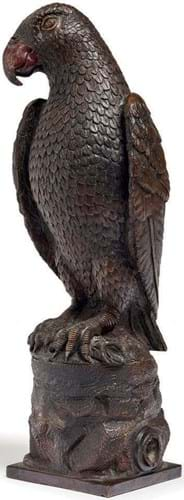
The bronze parrot on tree stump from c.1600 was possibly once part of a table clock. The 11in (27cm) high figure doubled its estimate when it was sold for €14,000 (£12,170) at Neumeister.
Among the bronzes was an 11in (27cm) parrot on tree stump from c.1600, which doubled its estimate and was sold for €14,000 (£12,170). It was possibly once part of a table clock.
On the final day of the sale, a 16th century Flemish ivory figure of a standing Cupid went from €8000 to €21,000 (£18,260), even though its wings were missing.
A 17th century limewood figure of a male nude with a turban, 10in (25cm) high, was pushed from €1200 to €29,000 (£25,220), another purchase by a south German collector.
Provenance attention
Stoll takes matters of provenance very seriously. When, several years ago, a trove of documents relating to the wartime history of the predecessor company Weinmüller was discovered, she commissioned a scientific study to determine which pieces – and there were several – had been sold under duress or under dubious circumstances.
The results were published in a monograph and set a high standard for German auction houses. Although every notable piece in the current catalogue had been checked with the Art Loss Register and other databases, one lot – perhaps – slipped through the net.
Shortly before the sale, the museum in Gotha contacted the auction house and claimed that two early-18th century silver-enamel Augsburg saucers with mythological scenes, the work of the Augsburg master Tobias Baur, had been plundered from the museum during the war.
Stoll announced that until the question of ownership was settled, the saucers would be knocked down only provisionally. There were still enough bidders on hand who were prepared to take the risk and the price went from €20,000 to €80,000 (£69,570). It could take several months before the matter is finally resolved.
Neumeister sales have always been a prime address for genre paintings by 19th century artists, many of whom came from Bavaria and made a living painting their local or regional landscapes.
Nowadays, if a specific location is identifiable, certain bidders will (almost) stop at nothing to claim their prize. A case in point was Johann Sperl’s (1840-1914) The River Jenbach near Bad Feilnbach with a View of the Wendelsteingruppe, a 19 x 14in (48 x 36cm) canvas which was driven by a phone bidder and a competitor in the room from €5000 to a substantial €66,000 (£57,390), with a south German collector winning the day. This is an auction record for the artist.
On the other hand, a north German collector secured Carl Blechen’s (1798-1840) small View of the Gulf of Naples from 1828 (previewed in ATG No 2412) for €22,000 (£19,130), slightly over the upper estimate.
Also worthy of note was a pencil and wash drawing attributed to the British painter William Henry Brooke (1772-1860) with the gruesomely telling title Sale by Auction of Slaves, Pictures, Estates and Merchandise in the Rotunda of Exchange, New Orleans. It was sold for €4000 (£3480), 10 times the estimate.
All pictures featured in this article are copyright NEUMEISTER/Christian Mitko.


